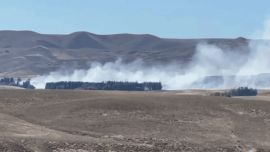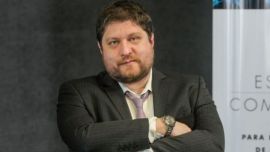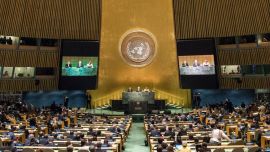Just nine deputies of the 34-strong Radical caucus (those elected last year and not up for renewal) will still be sitting tight in their seats after next spring’s midterms – every danger of Argentina’s most venerable party spanning three centuries sinking from its current disarray to virtual disappearance by then.
The Radical crisis perhaps stems from standing or falling from being the men (no female leadership or presidential candidates to date) in the middle in many senses – representing a middle class facing extinction and a middle ground squeezed out by polarisation. The latter problem is compounded by having a party chairman with neither a past nor a future in the Unión Cívica Radical – Senator Martín Lousteau, who only joined the party seven years ago and whose agenda is totally driven by his City mayoral ambitions. Previously the PRO grip on City Hall made the Radical niche within the dominant Juntos por el Cambio coalition his best route – with the virtual collapse of that coalition his best bet is now lending his name to a Peronist opposition otherwise standing little chance. A dozen Radical deputies follow their chairman, almost all the rest feel trapped by President Javier Milei’s “all or nothing” grandstanding into broadly supporting him and that middle ground has become a no man’s land.
The Radical quandary can also be traced back to its origins and to a name which often puzzles outsiders. The party began life in 1891 as a splinter of the youthful Unión Cívica driving force of the 1890 Revolution (the other splinter, the Unión Cívica Nacional, lost all point with the death of its leader, ex-president Bartolomé Mitre, in 1906 and was dissolved in 1916, merging into the UCR, then Argentina’s brand-new government after the first democratic elections). Rather than an ideological statement, the choice of the word “Radical” reflected the immigrant society of late 19th century Argentina – the French Radicals were a frequent ruling party in the Third and even Fourth Republics while their Italian counterparts, although second fiddle nationwide to the Liberals in pre-fascist Italy, governed many major northern and central cities, including Rome. An old French political joke argued that their Radicals should be called radis (the French word for radishes) for short because like the root vegetable, they were red outside and white inside. A pun which fits the Argentine Radicals perfectly – despite being members of the Socialist International since 1996.
During their first two decades, the Radicals were a frankly revolutionary party (with armed uprisings in 1893 and 1905) until clinching universal manhood suffrage in 1912, followed by electoral victory in 1916 when Hipólito Yrigoyen reached the Presidency with 370,000 votes. His first term featured creation of the YPF state oil company, university reform, the eight-hour day and neutrality in World War I while also slapping trusteeships on provinces at the drop of a hat. He was succeeded by the somewhat indolent presidency of Marcelo T. de Alvear (1922-1928) who flourished from the effortless growth of an Argentina with more cars than France and more telephones than Japan. An ageing Yrigoyen then returned to power but his imperious personality had hopelessly split the UCR since around 1920 and the world crash of 1929 gave him no chance, succumbing to a military coup in 1930.
This brutal end to UCR rule did not prevent Argentina from having at least nominally Radical presidents in 10 of the 15 years of military control, electoral fraud and the “infamous decade” of the 1930s between that coup and the advent of Peronism – Roberto M. Ortiz (1938-1942) was a mainstream Radical while even General Agustín P. Justo (1932-1938) was nominated by the anti-Yrigoyen wing of the party. As from the creation of the nationalist FORJA youth grouping in 1935, Radical sectors started to swing left, culminating in the almost socialist Avellaneda Programme of 1945, but it was too late – Peronism was already on its way.
The 18-year ban on Peronism imposed by the 1955 coup saw three more presidents of Radical origin – the Intransigent (UCRI) Arturo Frondizi thanks to Peronist votes (1958-1962), the caretaker José María Guido (1962-1963) and Arturo Illia (1963-1966), elected with just a quarter of the vote. Raúl Alfonsín more than doubled that percentage with his upset win in 1983 following the traumatic 1970s and the 1976-1983 military dictatorship while Fernando de la Rúa (1999-20001) lasting only half his term rounds out the list of Radical presidents – both administrations worth columns in their own right.
This century has not been kind on the Radicals with perhaps the lowest point being the 2.34 percent of the vote eked by their candidate Leopoldo Moreau (now an ardent Kirchnerite) in the 2003 elections whereas the ex-Radicals Ricardo López Murphy and Elisa Carrió polled over 30 percent between them. The search for highlights in this century yields little more than the ostracised vice-presidency of Julio César Cleto Cobos (2007-2011) and being an extremely junior partner of the Juntos por el Cambio coalition ruling Argentina between 2015 and 2019. Starting this century with 2.6 million card-carrying members, the UCR today has 1.8 million.
This potted history shows men of Radical origin to have governed Argentina for 40 of the 133 years since the party’s creation (or almost half the time between 1916 and 2001). At provincial level they are less thick on the ground despite currently governing five provinces – while earlier years would be more generous (especially with all the trusteeships in the 1916-1930 period), only 54 of the 264 gubernatorial or City mayoral terms since the return of democracy in 1983 have been filled by Radicals, who draw a complete blank in no less than nine of the 23 provinces, barely 20 percent.
Today the suspension of the five Radical “heroes” helping to uphold the presidential veto of the opposition pension bill has placed Rodrigo de Loredo’s caucus on the brink of rupture – it is extremely hard to see the likes of Lousteau and the Manes brothers in the same team as the conservative Mendoza Governor Alfredo Cornejo. Drifting anywhere but their traditional middle ground, it is also hard to find a place for Radical “ethics” in the current political scheme of things – Kirchnerism hogs the hawkish opposition while not even merger with the libertarians is a clear option to the right since the Juntos por el Cambio coalition remains alive in some provinces. Next year’s midterms threaten to be shades of those in 1987 when the joke was: What does UCR stand for? Unicamente Córdoba and Ríonegro (the only provinces then won).



















Comments